Espresso Coffee Machines - UK Reviews & Useful Buying Tips
On this page we look at "espresso" coffee machines or coffee makers. For many UK people buying an espresso machine is the next step in their relationship with coffee. For the main part they are keen to seriously take their coffee making and coffee brewing to the next level.
In terms of a very brief history the first espresso machine was invented in France around 1822. It was however in 1884, that the first patent for an espresso machine was made in Italy by a man called Angelo Moriondo from Turin.
Luigi Bezerra from Milan then improved and made changes to this design, and since then the espresso machine has been developed by many of the brands that we know today.
This is a long article, and I know some of you will not have time to read it all. So, if you simply want to know, which is the best espresso coffee machine, then we would recommend the Sage BES810BSS the Duo Temp Pro Espresso Machine
This is a very high quality machine, for making espresso, and all the other favourites like cappuccino, latte and mocha.
Different Types of Espresso Machine
Today there are three main types of espresso machine available on the market which are classified into:
- Manual - the buyer does all of the work and pulls what is called a pump handle to make the espresso
- Semi-automatic - this is a machine that requires some manual work but much of the other processes are automated. That includes automatic pump controls and boiler temperature settings
- Automatic - as the name would suggest the entire process is automated and our coffee is delivered at the touch of a button
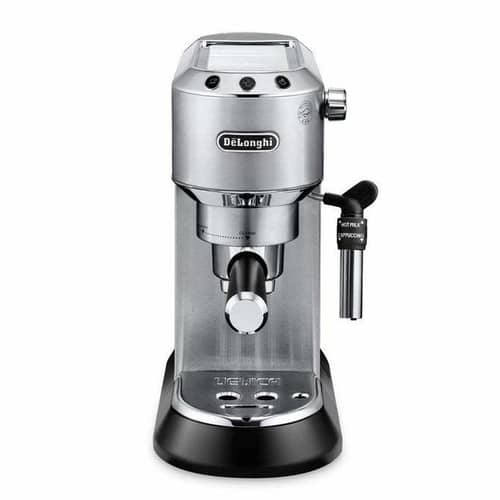
Pump Style Espresso Machine
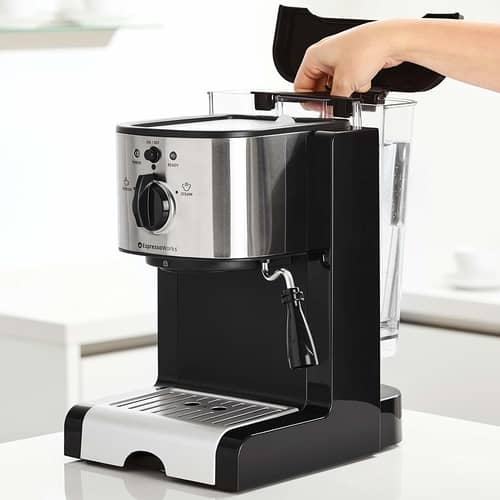


Semi Automatic Espresso Machine
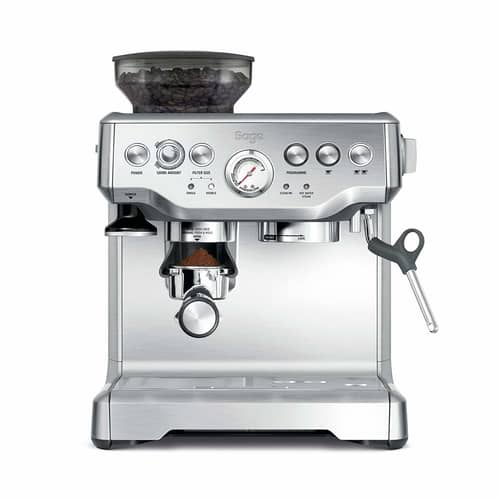


Automatic Espresso Machine
You can see from the three images above that they do look quite different to each other. They all make an excellent espresso of course, and in the main, your choice will come down to which style you prefer.
How Does an Espresso Machine Work?
An espresso machine forces hot water through tightly packed, finely ground coffee beans. At the other end an intense cup of coffee is produced. All of the early models were steam driven, and for the most part that steam/boiler operation still exists.
There are a lot of espresso machines out there that will do this job. It is worth noting that there are also a number of machines that do a pretty bad job of making good quality coffee.
We mentioned the three types above, manual, semi-automatic and automatic. The vast majority of UK buyers will purchase either a semi-automatic or an automatic machine.
The manual machine or "pump machine" does require certain skills, and learning those will put many people off buying this type of machine. It is however a great deal more fun to use.
If you are in the market for an espresso machine, then hopefully this buyer's guide can help you make the best choice.
What are the Important Features of an Espresso Machine?
Coffee machines come with a whole range of features. Some of those are certainly nice to have, but some are vitally important. We have included those important features below.
We would honestly recommend that any machine you buy has the important features listed below. Hopefully we can explain why that is the case.
Usability of the Machine
Always check how the portafilter fits into the group head. Check also that this is an easy thing to do and that the fit is tight.
Always check there is enough room between the portafilter and the drip tray, to make sure there is enough room to place your favourite cup or mug under the spout.
With the better espresso machines this height can be adjusted. If the height is fixed you will have to use a cup that fits under, and over time that can get very frustrating.
Pressure
You always want a machine that can deliver constant pressure. This is measured in "bars." Nine bars is the standard espresso measurement, and with advancements in technology, most quality espresso machines can deliver around 15 bars.
Always check the bar pressure on any machine that you are going to purchase and make sure it is at least "9 bars."
Temperature
This is a feature that many new buyers often neglect to look at. The perfect temperature for brewing coffee is between 90-96 degrees Celsius. Boiling water at 100 degrees actually scolds the coffee grains.
Like the pressure of a machine, you also need a consistent temperature to make quality espresso time after time.
Make sure any machine you buy has that 90-96 degree bandwidth.
Build Quality
The way a coffee machine is made, and the materials it is made from, are what will ensure the durability of your coffee machine. Our advice is to avoid plastic and where possible get a machine made of a metal such as stainless steel.
These types of machine generate a lot of heat and pressure, and ideally if you stick with a good brand name, you get a good build quality.
The parts need to be well made and the overall build needs to be tough and durable, and that is more important than the actual appearance.
The Steam Wand
Many coffee drinks make use of milk that has been frothed. To be able to do that you need a machine that allows you to control how much steam you want to use. There are many machines out there that simply have an on/off system.
We would recommend avoiding those and sticking with something with a more traditional knob/dial where you are in control of the steam output.
That is important if you want to make coffee drinks such as latte and cappuccino.
There are plenty of other features on espresso machines. However, those that we have listed above are the most important to make sure you get consistently good coffee when you need it.
Just below we have a diagram of an espresso machine that points out those important features.
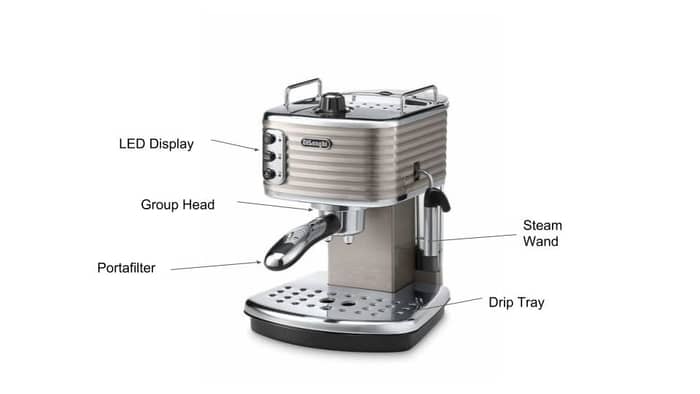


Just below we go into each of the three types of espresso machine in more detail.
Best Automatic Espresso Coffee Machines
Automatic espresso machines are also known as "bean to cup" machines. The reason for that is that you buy your coffee beans. Once you have those you fill your machine with water, and pour the beans into a hopper on the top of your machine.
On your bean to cup machine you will have a menu, usually an LED display. From there you select your type of coffee that you want, and hit a button. The machine then uses a built in grinder to grind the beans.
At the same time it also heats the water to the perfect temperature. When heated it then brews your coffee, and all you have to do is wait on your espresso coming out the bottom of the machine.
We have done a full buying guide along with recommendations for the top 10 buyer rated bean to cup coffee machines. If you would like to read more about those, then please click on the button below to do just that.
These are the best type of espresso machines that you can buy. They are fully automated and take the pain out of making great tasting espresso coffee.
Almost all of those will also have an automatic descaling program and self-cleaning programs built in.
Best Semi-Automatic Espresso Machines
Most people will go for the automatic option as they do take a lot of the guess work out of making coffee. They are also a great deal easier to use. They are however an expensive option, and one that will be outside the available budget of many people.
In addition to that, if you are someone who enjoys the process of making coffee, then they also remove almost all of that process. Many coffee lovers like to grind their own beans, do their own tamping and that allows them to experiment with different tastes.
To be able to do that you will need a semi-automatic espresso machine. These are a more affordable option and do allow you to get more hands on with the brewing process.
You will need to own a coffee bean grinder, or you can buy beans that have been ground already. Just be sure to check the package and make sure they are suitable for making espresso. The grind is a very fine one for espresso machines.
You then put the grinds into the portafilter, and from there the machine simply takes over, once you have filled it with water. These semi-automatic espresso machines will have a boiler to heat the water, and some form of coffee drink selection option.
Usually that is an LED display or can simply be a dial. You pick the drink and then the machine will brew your chosen drink.
Many of these will also have a steam wand or an alternative method for making steam that you can use to froth your milk.
There are a lot of choices for these on the UK market. The one we recommend to most people when starting out is the VonShef 15 Bar Espresso Coffee Machine.
You can see an image just below.
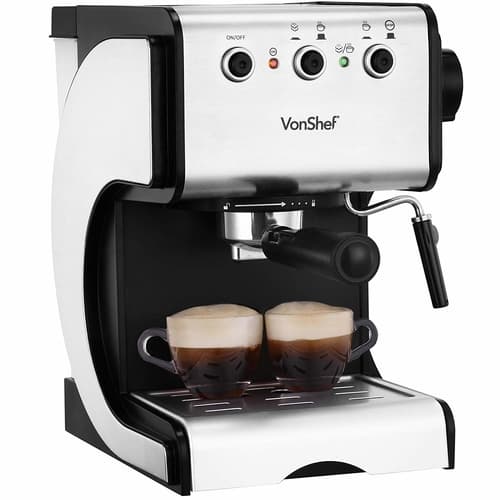


That is because it is affordable, (usually under £65) makes great espresso and comes with a 2 year warranty.
You can read our review of the VonShef 15 Bar Espresso Coffee Machine by clicking right here.
Best Pump Espresso Machines
Owning one of these allows you to be in full control of making coffee in the very traditional way. These pump machines are certainly an interesting choice.
Many people say that these pump espresso machines are for the real coffee connoisseur, and for those who enjoy the experience of making great tasting coffee.
The two main brands who make these are De'Longhi and La Pavoni. La Pavoni make the original lever espresso machines and those are very expensive, but very traditional.
De'Longhi is a well known Italian coffee machine brand, and they also make a few models of this pump style. La Pavoni are however the best known for this type of machine.
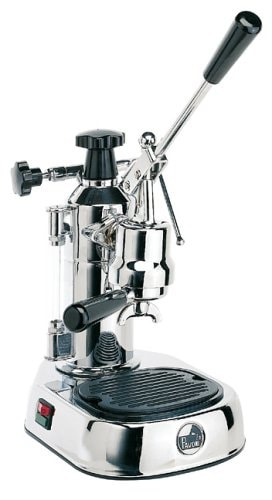


La Pavoni Europiccola Lever Espresso Machine
This is not a cheap option, but it is of extremely high quality.
What is an Espresso?
The term "espresso" is often mis-pronounced "expresso" and that has led many people to believe that an espresso is a fast coffee. That of course is not true and is one of the many coffee myths.
An espresso is in fact the key element of coffee culture. When you think espresso is it a bitter sweet shot with a caffeine kick. It is the key ingredient for many other coffee drinks such as Americano, Latte and Cappuccino.
This is by far the most common coffee preparation technique in coffee shops up and down the UK. Filter coffee, also known as brewed coffee is starting to trend again, but the espresso is by a distance still the core element of most coffee shop drinks.
With this small shot there is also the crema, and that shot with the crema is all down to the way in which this is made. Pour over brewing such as drip and filtered coffee uses a method where hot water is given time to coax out the flavour of the coffee grinds.
The espresso shot though is a much more aggressive process. Almost boiling hot water (90-90 degrees Celsius) is forced through very fine coffee grounds and the shot is made in about 23-28 seconds.
This is a much faster method than any type of pour over brewing, and may be another reason why people call this shot an expresso.
Some Interesting Espresso Facts
When fine grains have pressurised water forced through them, that water extracts both solid and dissolved components from the grinds. That is what makes this small shot so very intense.
It is also this pressure which develops the crema. The crema is actually a rich velvet cream, and is a product of the CO2 in the beans. That gas escapes during the process to create thousands of small bubbles.
These bubbles are coated in melonoidins which keep them from bursting. Crema does not last long. If you have ever been to Italy, then coffee shops there will encourage you to drink the espresso shot within just 10 seconds, as after that the crema starts to break down.
Likewise when making a latte, you really only have 10 seconds to add the milk to the espresso, if you want to make use of the crema.
Blend and Roasting
The espresso shot has got no relation to the blend or the type of roast used on the beans. The term espresso simply refers to the way the shot is made. Most espresso is made from a dark roast, though baristas are now starting to try out lighter roasts
Best Espresso Machine Conclusion
Hopefully you are much better informed about the wide range of espresso machines that are currently available on the UK market. As you have read there are three types, the automatic, semi-automatic and the pump style machines.
Most buyers will either opt for an automatic or a semi-automatic espresso machine. The pump machines look great, are expensive and do take quite a lot of trial and error to master.
The semi-automatic will suit many people as they can still grind their own coffee or buy a pre-ground coffee, and then use that with their machine. There is some work involved with this brewing process, but these machines are affordable as they start from around £100.
For those who want a machine that just makes excellent espresso without any of the work, including cleaning the machine, then opt for a fully automatic bean to cup coffee machine.
Resources Used
We create all of our own content here at The Perfect Grind website. We do however also check with the leading coffee industry websites.
So when creating an article as long as this we do reference quite a number of other credible information sources. We have listed most of these below:
